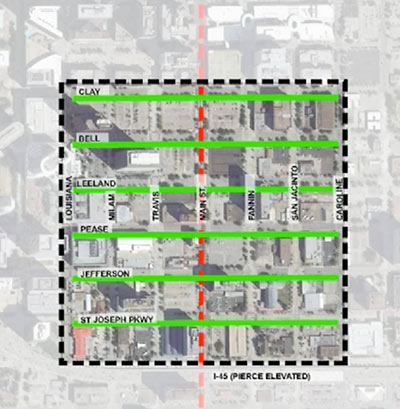
Architect John Kirksey has an idea for building a park on 36 blocks in south Downtown — just north of the Pierce Elevated, between Louisiana and Caroline. But he doesn’t own the land, and he’s not proposing to buy it up. So Kirksey’s plan isn’t for a single park space — it’s for a bunch of linear walkways. Okay, call it a series of extra-wide sidewalks on the east-west streets. Here’s how it might look, driving through:
***
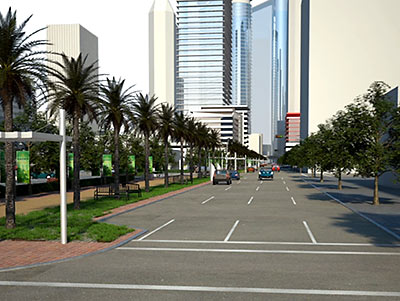
Most of this section of Downtown — south of Clay St. — isn’t tied into the tunnel system, and good portions of it remain undeveloped. Since 2000, shortly before construction began for the new light rail line along Main St., car traffic on the east-west streets has dropped considerably. So why not take away a lane or 2 of traffic from those 5-lane streets, Kirksey suggests — and perk up the sidewalks with some wider, greener, and more pedestrian- and bike-friendly spaces — like these?
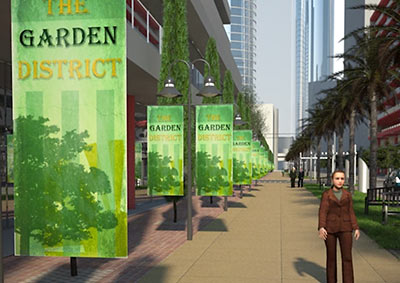
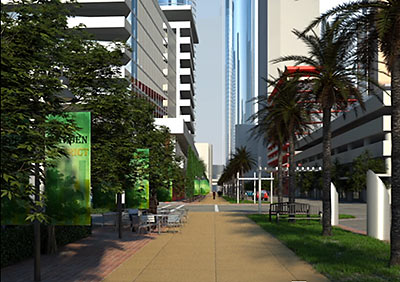
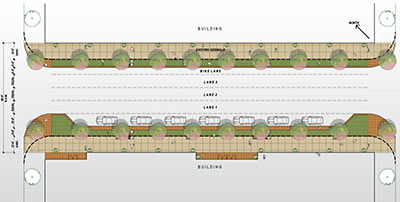
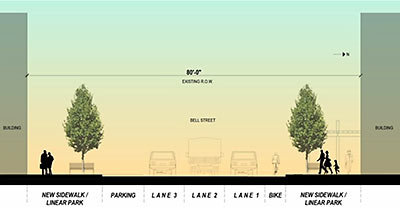
Kirksey’s original proposal, which his firm first floated almost a year ago, was a bit bolder, and the results would probably have been more park-like: Instead of grabbing 6 ft. of street width from each side of the east-west streets, he wanted owners of adjacent land to contribute 10-ft.-wide strips of their own property; he’d combine that with 10 ft. from the traffic lanes to create roomy 35-ft.-wide pedestrian zones on the south sides of each street.
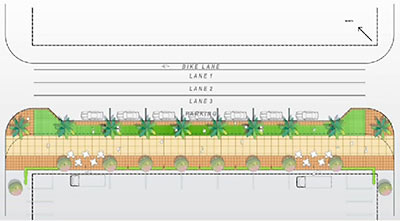
(The north sides would have stayed as they are.) He argued that landowners would likely be automatically compensated for their donations of land by a resulting increase in land values:

Apparently, that idea didn’t fly with the owners.
Here’s a video of Kirksey’s full presentation. The first part, from last May, includes a fly-through of the original park concept at the 12:08 mark; a minute and a half later, it’s updated to the current proposal:
- CBD Vision 36 update [Vimeo]
Images: Kirksey Architecture


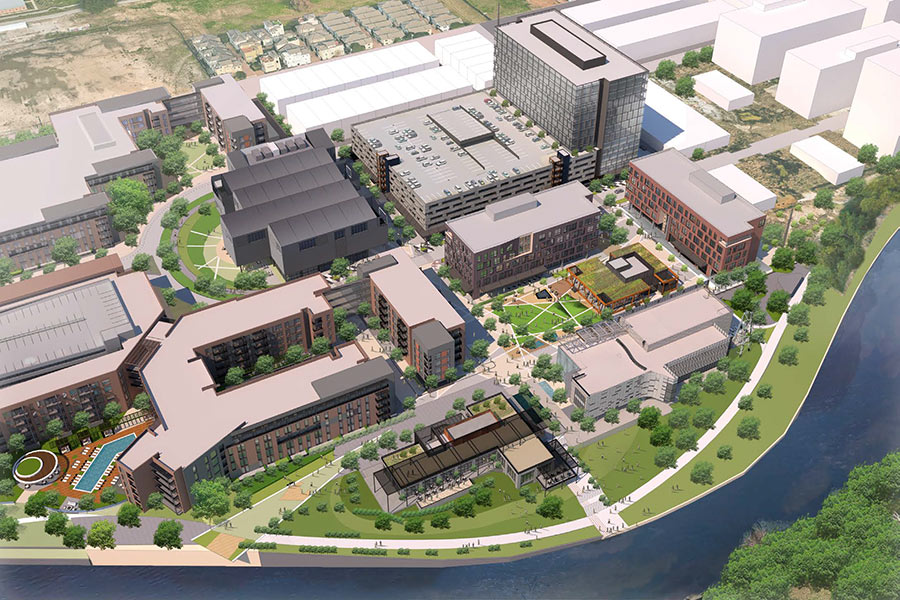

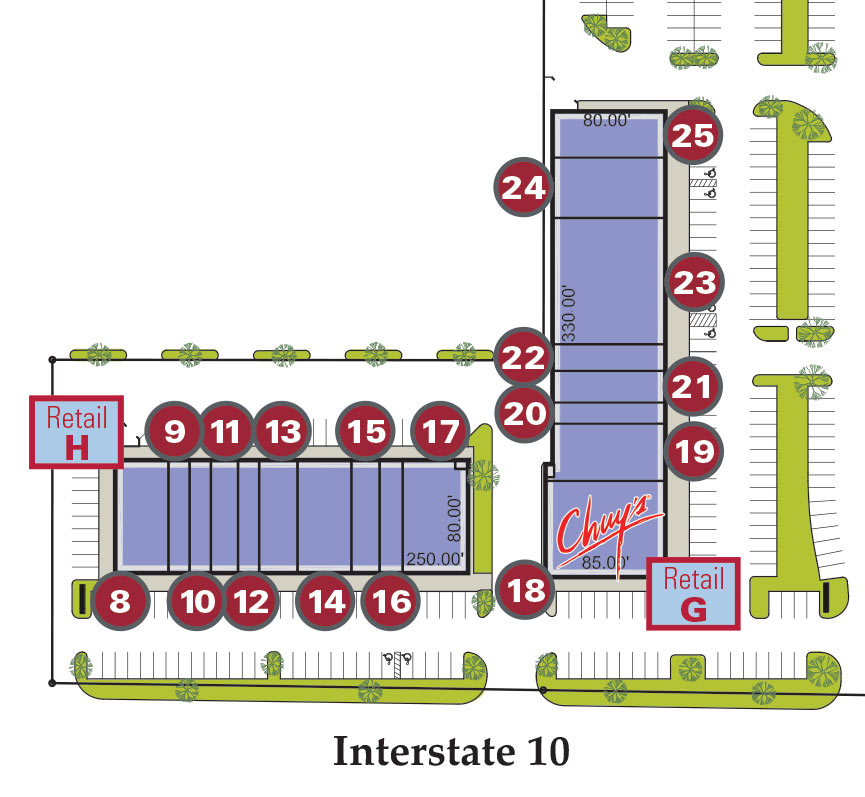
I like it how people make grand plans for properties they don’t own and then get laughed out of the office for pitching it to the property owners. It’s obvious whoever came up with this plan, has no clue about intricacies of land values, price per sq. ft., ROI’s, etc.
Starting with something too ambitious and scaling it down is better than starting with a compromise though. It show’s what’s theoretically possible, and helps make clear what’s truly valuable about the scheme.
As long as they DO NOT PLANT PALM TREES, this has my support.
While I really like the idea, if the amount of traffic on those E-W streets has fallen off enough for such a project to be conceived, why not allow more parking on them?
@commonsense: LOL–Yes, I’m sure John Kirksey and his team have NO IDEA how land value works.
The older first proposal would have been pretty sweet. Unfortunately the updated plan does seem like a glorified sidewalk as someone mentioned on HAIF. :(
A+ for effort though. I think the new plan would still be an upgrade, of course.
And the landowners have done such great, highly profitable things in that part of town, how could their judgement be questioned?
So traffic has fallen off, giving the wiggle room to sacrifice some ROW in order to make an improvement that will cause property values to increase because end users finally want to do something with the land that will create traffic. The logic — it is circular.
Also, I really don’t like the palm trees or the number of banners. The focal point of a “Garden District” should not be banners.
Commonsense…you’re a hack.
I bet I’m not the only one that would love to hear about YOUR experience with the intricacies of land values, price per sq. ft., ROI’s, etc.
Surely you’re more versed than a practicing architect whose namesake firm has been in existence for 40+ years.
What is the deal with banners every 5 feet?
YOU ARE IN THE GARDEN DISTRICT
YOU ARE IN THE GARDEN DISTRICT
STILL HERE
YOU CAN NEVER ESCAPE HAHAHAHAHAHAHAHAHAHAHAHAHAHAHAHA
@JD, the evidence speaks for itself, the WERE laughed out of the board rooms.
—
This project sound to me like “Hey, we got a new intern, put him to do some busy work, but don’t let him mess with any real clients’ project”
—
I’m also guessing that the reason the area has seen less traffic after the rail went in is not because the people take the train, it’s because the train itself makes the area less passable and more frustrating for cars.
Really commonsense? For me personally, the rail makes me less likely to drive down main, but other than that I’m not sure how it makes driving more “frustrating.” The crossings are perfectly normal intersection that had lights before the train.
Great idea, but silly at the same time… only in Houston would you call that a “park” in any other city that is just what a normal sidewalk looks like. Extra-wide to encourage pedestrian activity and a line of trees… def not a park… just a normal sidewalk.
If anything, this speaks to the horrid state of sidewalks in this city. Why can’t Houston just own the sidewalks like any other city and mandate changes like this. Its suprising how much a nice sidewalk encourages people’s interest in wanting to go downtown…
I wonder if the builders of the Keystone Pipeline were ever sidetracked in their planning efforts by the fact that they didn’t own the land between Canada and Houston.
Good intentions but a seriously bad idea. Turning Main Street into a cheezy retail mall environment will kill Downtown.
Yes please.
There’s a much cheaper alternative, just install banners and call it the empty building and parking lot district. No further work required.
It seems a lot like the Cotswold project they built around Market Square. How has that worked out?
No palm trees please!! Why do people still think it’s a good idea to plant them in a non-tropical, urban location? They provide little to no shade, take forever to grow, and aren’t particularly pretty.
@Heightsman: +1000
A really wide sidewalk is not a linear park.
I live around the corner from there at 2016 Main St. This idea would be nice but I don’t know what else it would do to the area. Are business going to want to relocate down there because it now has a wide sidewalk? Now just more room for the homeless to sleep!
@ Anse – lol!
OH NO!!! A RESPECTED LOCAL ARCHITECT HAS A SLIGHTLY OUT OF THE BOX IDEA ON HOW TO SET INTO MOTION A TRASNFORMATION OF AN UNDERPERFORMING SECTION DOWNTOWN HOUSTON!!! CALL HOMELAND SECURITY!!! BETTER YET, CATO INSTITUTE!!!
Really, people. I doubt this is so far along that they have committed to palms instead of live oaks or crepe myrtles. This idea might just help this area redevelop and avoid the mistake downtown made by shoving all the lunch spots underground, leaving no street life.
Anse lowers the boom (pun intended).
I had a strung out meth chick hit me up for money downtown friday. I pointed to California and said “keep walking in that direction”
South Downtown is probably the grayest part of Houston. Smart idea to make it look a bit more green. Even if it did nothing at all to improve pedestrian activity (which is dubious considering the new residential tower going in), it would still make our city look better to the hundreds of thousands of cars that traverse the Pierce Elevated daily.
Those of us that actually worked downtown liked having the lunch spots in the tunnel. Much cooler in the summer, dry when it’s raining and no riffraff.
If more residential gets built in that section of downtown, similar to Skyhouse, this could prove to be an amenity that would be welcomed.
The idea that it is too hot in Houston to support any pedestrian life is bunk. Denver has had a very busy, pedestrian oriented “16th Street Mall” there for over 20 years, and Denver weather between December and April is as bad to be out in as Houston from June to September.
Anse for the win!
@JCR: I actually work downtown. I have been working downtown for over a dozen years. The tunnels are a good way to keep people cool while walking from building to building, but they are a terrible place for restaurants. There is nothing enjoyable about eating in a fallout shelter. New/rennovated underground food courts in One Allen, Commerce towers and the building on Main that has the different colored lights at night have all floundered to fill up. Meanwhile, there are loads of great new spots opening streetside (Barnaby’s, Burger Guys, Georgia’s, Phoenecia, Bombay Pizza, etc.). And it turns out that you can run an air conditioner and keep things nice and cool street level.
Palm trees? Houston – the city that wants to be anywhere else but here.
I love eating lunch in the tunnel. I also love going walking in the tunnels – no climate to deal with and no riffraff like in a park. I wish I could just go from my car to my office, etc., and never have to leave a tunnel. (How do you satirize this??? I’m trying to make this sound ridiculous, but I think this is actually what a lot of these people would say!)
For the record, Kirksey didn’t come up with this idea on his own, he was asked to come up with a plan for that part of downtown by a group of the landowners who own a majority of those blocks.
While we’re at it, maybe it’s time to start reconsidering the placement of bike lanes within the context of traffic. Other cities have gone the route of having street parking serve as a “buffer zone” between bike lane and traffic, giving bikes an actual lane to use instead of a gutter filled with trash, glass and broken concrete slabs, and also alleviating bike vs car confrontations.
This project could work in a couple ways, but not as the awkward conglomeration proposed.
Viable option 1: Enable walking/cycling access downtown. To do this, unclutter the design; the banners and trees will just get in the way. Better yet, widen the sidewalk by just 2-3 feet, which is plenty for pedestrians, and then close down the rest of a lane as a designated bike path. Walkers and bikers don’t mix well. And instead of doing this on every street in a little chunk of downtown, do it on every 4th or 5th street (North/South and East/West) over as much of downtown as possible. Create corridors, not an island.
Viable option 2: local beautification. This is where all those trees make sense. But, no one comes to a place just for grimy sidewalk trees, so it should be someplace with other attractions, which the current site is sorely lacking. There’s unnecessary dispersion of effort in this plan as well – better to take a bigger chunk of every third street and create something big enough to enjoy.
Has anyone compared Houston’s downtown to other cities to see how it rates? Chances are, if you’ve traveled and seen other downtowns, Houston’s. . . sucks.
There are pockets of nice areas. But overall, it’s ugly, the sidewalks are gross and it’s, basically, dead.
Houston could take hints from Midtown Atlanta, where the sidewalks have been widened and street planters add greenery. People walk around and enjoy it. Same goes for Denver.
We could use more public art, or at least light up the sculpture and murals so you can see them at night.
I think the palm trees are great. They’ve survived all over Houston. It’s one of the benefits of a more tropical climate. You don’t see them in Austin or, Heaven forbid, Dallas.
Let’s embrace the palms! They add character and only attracts insects and rodents when they’re not properly trimmed. Don’t people realize you’re not supposed to see the giant dead part underneath? Trim that garbage!
Another mediocre project that could be so much more.
No palm trees!
@Tanner, an even closer example is Austin’s 2nd Street corridor. Trees, sidewalk cafes, theater, a cinema, a hotel, all created in the last 6 years. And people walk it even in August!
You guys do realize that palms are native to southeast Texas right?
When working on St. Joseph property about 15 years ago, they had Live Oak street trees which were the habitat of thousands of Gackles. Needless to say, it was uncomfortable to walk there, and nothing seemed to get rid of them. We planted palm trees because birds don’t nest in them. The solution was suggested by SWA, probably Houston’s best Landscape Architects.
@ mfastx: Palms (native and non-native) look great at random intervals. I just don’t like them as a theme in an urban core that doesn’t front a beach.
Houston’s theme is live oaks. Plant those. As for the grackels…shoot them!
What’s with the anti-palm tree look? I guess everybody here hates California. Having grown up in SoCal, I love palms and SoCal does them well. Houston sucks when it comes to landscaping. We have a few great neighborhoods with old oaks, but most of the Houston trees are flat out ugly.
This is what happens when building architects start working outside of a property line with a blanket approach to a neighborhood without much of a nod to the context. And NO PALMS.
Palms are great in any location. We are considered sub-tropical in climate, and as it gets hotter here, the plant zones are moving north. Like this concept. Live Oaks are great, but they need a lot of open space to thrive, not a downtown street scape. Also, although many contributers to this site are too young to remember, in some parts of the county American Elms were everywhere…until an imported disease struck killing almost all of them. Streets that were lined with trees were over a year or two rendered bare. We run that risk with the number of Live Oaks we use for landscaping here. Anyway, what is the problem with dreaming about possiblities like this? Last time I did some reading on Houston history, this kind of creativity and dreaming is what created some of our best stuff. Ideas like this are what creates the future, not the individuals who think that everything new that is proposed is a dumb idea (unless of course, it is a highrise in a residential neighborhood :)!.
Tell us more about the architectural “context” of surface level parking lots.